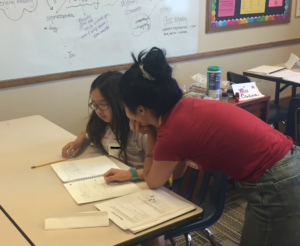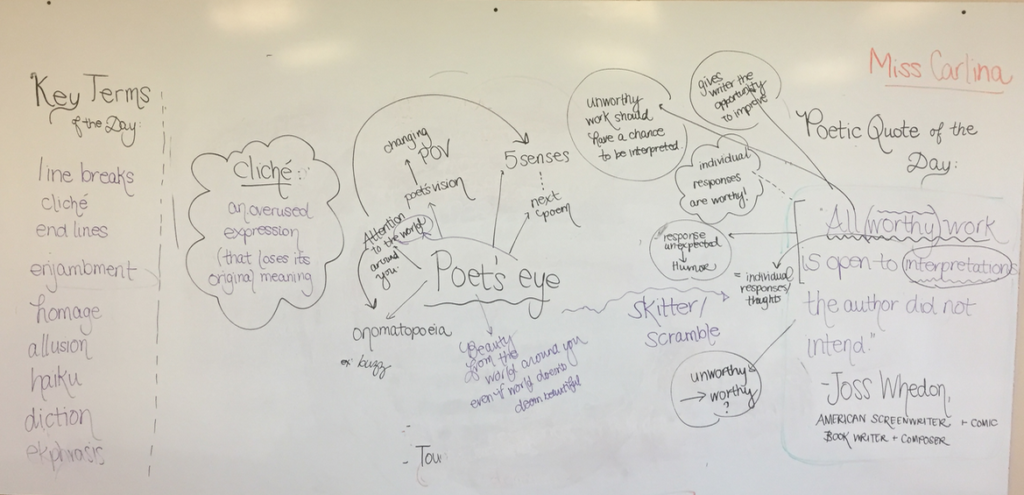Summer SAVY 2018: Session 5, Day 3 – Poetic Play (Rising 3rd/4th)
Happiest Wednesday of Poetic Play! The week is whipping by!
This morning, students worked on a creative writing exercise with “PoetryCubes” (adapted from the wonderful game, StoryCubes.) Students were each given a special “image-dice,” and asked to roll their dice, choose a category on the board (each category included one of the five senses, and a literary technique we’ve discussed thus far as a class, i.e. alliteration, similie/metaphor, etc.) and write one line based off their rolled image using these techniques and a sensory detail. This generative writing exercise seemed to infuse a lot of inspiration for the students, many of whom resumed working on their PoetryCube poems throughout the day.
We moved on to our Quote of the Day, by the American screenwriter, comic book writer, + composer Joss Whedon: “All worthy work is open to interpretations the author did not intend.” Students talked in their table-groups about their thoughts on this quote, and we came together as a larger class to REVISE Whedon’s statement. As a collective class, in fact, we believe that ALL work is worthy of interpretations that were unintended by the authors, and that unexpected interpretations by readers can actually inform and allow the writer for more opportunity to grow. Students came up with personal examples, such as unintended responses of humor that peers exhibited towards their own work, which, in turn, influences the future of their writing!
We discussed the Poet’s Eye as a class: What does it mean to have a “poet’s eye”? How might poets move through the world witnessing and observing in more intent or different ways, knowing that they must, at the end of the day, write a poem? We discussed the ways that poetry might create beauty from unexpected or unbeautiful objects/places/things. Students then completed a Ways of Seeing exercise. Students were split into groups of two or three, and each group assigned a Describer. Each Describer was given a New Yorker Magazine cover, and instructed not to share this image with the rest of his/her group. Instead, the Describer, through language, had to describe the image to his/her partner, while their partner drew the image on a piece of paper. The goal of this exercise was to have students see the purpose of offering specific language and detail into their own writing, in order to paint more vivid portraits in the reader’s head. We also discussed, as a class, the difficulties of describing a work of art specifically, and the multiplicity of interpretations inspired by it.
After the students’ ORA (recreation) time, we moved on to learning about Ekphrasis: vivid descriptions of scenes, more commonly works of art. Students viewed Bruegel’s “Landscape With The Fall of Icarus,” (1555) and were given brief context for the story unfolding within the painting. We then read William Carlos William’s poem after this painting, “Landscape With The Fall of Icarus.” Students learned about Homages and Allusions, and the ways that poems can respond to works of art both directly and indirectly. We also meditated on what poems can expand or offer to a work of art that may not be previously there. Finally, we discussed the ways that visual art can give focus to your writing and create an interesting dialogue for your work!
It was the students’ turn, next, to create their OWN ekphrastic poetry based off of a painting. Students were given three paintings to choose from:
- Giacometti, by Pablo Picasso
- My Front Yard, Summer, 1941, by Georgia O’Keefe,
- The Persistence of Memory, by Salvador Dali
Students spent time observing their selected works, and then wrote a poem based off their chosen work of art. We had some fantastic ekphrastic interpretations of Dali’s “The Persistence of Memory,” in particular, and I encourage you to ask your students about their ekphrastic creations tonight!
Next, students learned about line breaks, enjambment, and end lines while reading American poet Jeff Kass’s poem, “Underneath.” This is one of my favorite poems to teach young writers, as it utilizes ALL of the tools that we are learning about in our classroom: from sensory detail to metaphor. Kass begins his poem with the following lines: “Under my shirt is my skin / under my skin is my heart / under my heart is…” In this poem, the reader is encouraged to think actively about digging UNDERNEATH yourself for layers and layers of memory, image, sense, and human emotion. Students studied the line breaks in Kass’s poem, and we pondered lines such as: “under two t-shirts / is this ham-fisted hop-skotchin’ / heart, and under this heart / is love,” discussing the ways that different line breaks can place different emphases for a poem, as well as control the pace.
Students were then invited to write their own “Underneath” poems — thinking intentionally about line break and structure. I asked students to imagine they had a giant grid on their bodies, and if they were to use a shovel and dig beneath their hearts…what might they find? This writing exercise intends to draw upon discovery within the writing process — we write, or dig, in order to discover. Students were asked to consider what lies beneath the surface of their everyday worlds. In other words, what is important to them? What matters? Students began beautiful and moving portraits of life “underneath” their hearts, and they will be excited, I’m sure, to share their results with you on Friday!
In the afternoon, we transitioned into thinking about Poetry in the Community. I introduced students to the Nashville Public Radio podcast, Versify, a podcast that focuses on poetry being worthy of everyday life. In this podcast, Nashville poets interview local residents, and create poems based off of the stories they are told. Students listened to short excerpts of Versify Episode #1, There’s No Cure, in which a local Nashville educator, Fred Bailey, speaks about his childhood growing up blind, and his passion for educating himself and those around him. Students heard very short snippets of his interview, and wrote down thoughts in terms of what stuck out to them. We discussed the differences in what our classmates were drawn to (different eyes/ears make for different poems!) and we then listened to the final poem in the process, deciphering techniques such as metaphor and alliteration within the podcast.
Next up, we had a lesson on Haiku and Basho, the great Japanese haiku-master. Students learned what haiku are, and how to create haiku that are set in the present-tense and rely upon one or two strong images working together. We read several haiku by Basho, and one haiku by Philip Appleman (inspired by Basho.) We then took a short “Nature Walk” near the Wyatt Center of Vanderbilt’s campus. Students took their writing notebooks to accompany them, and were encouraged to take observational notes on their surroundings. After coming back to the classroom, they had a chance to compose different haiku based on what they witnessed with their “poets’ eyes.”
We closed off the day with a new vocabulary word: synesthesia, and discussed how common logos like Skittles (“Taste the rainbow!”) includes synesthesia within their advertisements as literary/marketing devices in order to sell products. Tomorrow, we’ll talk a little more about how synesthesia can be used in metaphor and similie in order to create strong images in a reader’s mind.
To engage your students tonight, I would consider asking them about the intersections of different medias of artwork with poetry. Are visual art, music, literature, and other art forms completely separate from each other? How might we combine visual art and literature? Music and cooking? Fashion and sculpture?
Thanks for another starry day! Cheers to tomorrow.
Miss Carlina
Photos From Our Day


